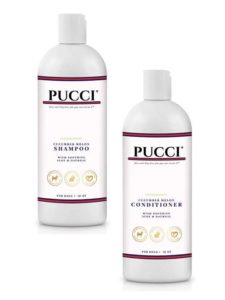Pet Pampering: Guide to Aromatherapy for Dogs

If you regularly use essential oils, it might be only a matter of time before you consider aromatherapy for your dog too.
Essential oils are prized for their refreshing and reinvigorating smell. They are known to provide a range of health benefits and are generally loved by all members of the household. But what about your pet?
Are essential oils safe for canines? Can you perform aromatherapy for dogs?
Whether you are an at-home aromatherapy fanatic who’s worried about the safety of their canine companion, or a dog owner specifically trying to treat their pet via essential oils, this comprehensive guide will certainly help.
Here I discuss some of the research I did and the basic concerns regarding the safety and effectiveness of aromatherapy for dogs, as well as lots of other useful information about using essential oils for your furry friend.
Aromatherapy for Dogs: Is It Safe?
Aromatherapy, or the use of essential oils, is generally considered safe for dogs as long as you follow proper steps and avoid certain types of fragrances.
However, it is best if you consult your vet before proceeding.
A vet can help you know better whether or not it is a good idea to perform aromatherapy for your dog. Let the vet know your pet’s medical history, and if they have any known respiratory problems or are suffering from any other health issues.
This will help the vet decide whether it’s safe to use essential oils on or around your dog or if it poses any risk for them instead.
Benefits of Using Essential Oils for Dogs
The reason why the trend of pet spas has picked up pace is that most of the benefits of aromatherapy for humans can be extended to dogs as well.
For instance, different types of essential oils can help reduce different physical ailments in dogs. This includes alleviating arthritic pain, treating nausea, improving digestion, boosting metabolism, and so on.
Essential oils can help calm down stressed out dogs, especially when their stress is triggered by traveling or if they are prone to separation anxiety.
Many pooch parents have witnessed firsthand the therapeutic effects of essential oils for their canine companions. These plant extracts often serve as a good alternative to traditional treatments. Plus, the best part is that they have no side effects.
How to Use Essential Oils for Dogs
Everyone knows that dogs have a sense of smell that is hundreds of times more sensitive than that of humans. So, you need to be extremely cautious when using essential oils around your dog.
The following tips will ensure that stimulating oils actually help your pet get back on all four feet:
Introducing the Oil
The ideal way to introduce your dog to essential oils is to let them get used to it on their own. You can put a few drops of diluted oil in a diffuser and place it somewhere around the house.
Make sure that there is an escape route for your pet. If they run out of the room or start staying outdoors, it’s a clear sign that they don’t like the smell. Change the oil variety or consider diluting it further.
Diluting
NEVER ever use essential oil for pets in its concentrated form. Given their acute sense of smell, if your dog sniffs the oil directly, it can cause them to vomit or lead to a headache.
To dilute the essential oil, use an unscented carrier oil such as coconut or almond oil. Keep the room well ventilated so that the aroma gently spreads throughout the place.
Application
Note: Under no circumstances should your dog ever lick or ingest essential oils!
Some aromatherapy products for dogs come in a spray bottle or roll-on sticks. If your pet approves of the smell and responds well to the blend, you can consider giving them a massage after spraying the mixture on your hands.
You must never apply essential oils directly onto your furry friend’s coat, even if it is highly diluted.
Some of the Best Essential Oils to Try with Your Pet
- Lavender – helps with relaxation, especially after car rides. It can also be used to fight inflammation
- Chamomile – good for nausea and skin irritations
- Spearmint – helps control appetite for dogs that tend to overeat
- Peppermint – good for treating sprains and alleviating pain in arthritis
- Cedar – helps in getting rid of fleas
- Eucalyptus – ideal for flea control and warding off other parasites that might find a home in your dog’s coat
- Lemongrass – can be sued to boost skin health and reduce dandruff
- Clary sage – good for reducing anxiety
- Thyme – beneficial for reducing muscle and joint pain in dogs with arthritis or rheumatism
Essential Oils That You Should Avoid Using Around Dogs
- Citrusy blends made from lemon or tangerine
- Tea tree oil
- Pine oil
- Wintergreen
- Ylang ylang
A Word of Caution
Given the rising popularity of aromatherapy for dogs, there is a wide range of products available in the market to choose from. However, keep in mind that not all of them are safe for pets.
You should only purchase essential oils from reputable sources. Furthermore, when buying an essential oil for your dog, carefully read the label to see if it contains any ingredients that your pet might be allergic to.
Additionally, you should pay attention to the following things:
- Distillation and/ or expiration date
- GS/ MS Testing – ensures that the product has been tested for quality
- NAHA Membership – oils endorsed by the National Association for Holistic Aromatherapy (NAHA) are premium quality products that you can safely use on pets
End Note
Aromatherapy for dogs can be an excellent way to improve your pet’s overall wellbeing. High-quality essential oils specially formulated for dogs can serve as a  powerful natural remedy for treating different ailments and reducing the symptoms of certain diseases such as arthritis.
powerful natural remedy for treating different ailments and reducing the symptoms of certain diseases such as arthritis.
However, to be completely sure that your effort to improve your pet’s health does not inadvertently lead to the opposite results, you must first consult a vet or a certified aromatherapist.
And for an unapologetic plug for our SPA products:: for the ‘Smell Good’ aspect of the conversation, you could just stick to PUCCI Cucumber Melon Shampoo and Conditioner, a pleasantly scented, soap-free, PH balanced pet shampoo/conditioner with odor control. puccicafe.com/shop/spa/pucci-cucumber-melon-shampoo
by Bobby J Davidson || You can’t buy love, but you can rescue it™ .
Facts About Animal Homelessness:
- Only 1 out of every 10 dogs born will find a permanent home.
- The main reasons animals are in shelters: owners give them up, or animal control finds them on the street.
- Each year, approximately 2.7 million dogs and cats are killed every year because shelters are too full and there aren’t enough adoptive homes. Act as a publicist for your local shelter so pets can find homes. Sign up for Shelter Pet PR.
- Approximately 7.6 million companion animals enter animal shelters nationwide every year. Of those, approximately 3.9 million are dogs and 3.4 million are cats.
- According to the National Council on Pet Population Study and Policy (NCPPSP), less than 2% of cats and only 15 to 20% of dogs are returned to their owners.
- 25% of dogs that enter local shelters are purebred.
- About twice as many animals enter shelters as strays compared to the number that are relinquished by their owners.
- It’s impossible to determine how many stray dogs and cats live in the United States. Estimates for cats alone range up to 70 million.
- Only 10% of the animals received by shelters have been spayed or neutered. Overpopulation, due to owners letting their pets accidentally or intentionally reproduce, sees millions of these “excess” animals killed annually.
- Many strays are lost pets that were not kept properly indoors or provided with identification.
- According to The Humane Society, there are about 3,500 brick-and-mortar animal shelters in the US and 10,000 rescue groups and animal sanctuaries in North America.
Here are a some adoptions for consideration: puccicafe.com/adoptions
